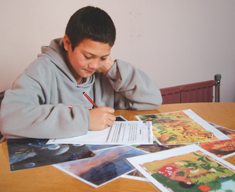![]() KOHIÄ
NGÄ TAIKÄKÄ – ISSUES IN TRANSLATING NEMP TASKS
INTO TE REO MÄORI
KOHIÄ
NGÄ TAIKÄKÄ – ISSUES IN TRANSLATING NEMP TASKS
INTO TE REO MÄORI
![]()
Joe Hunter and Liz Eley
Over
the last few years, NEMP has been assessing students in te reo
Mäori, mainly using tasks originally developed to be administered
in English. The transfer of assessment tasks to Mäori has
raised a number of issues, but it has not been possible to bring
a blanket solution to some of these problems, as different concerns
are evident in each curriculum area. This report presents an analysis
of some of these issues. |
| Since 1999, at the Year 8 level only, a special sample of 120 students whose learning takes place in Mäori immersion settings has participated in NEMP assessments conducted in te reo Mäori. The achievement of these students has subsequently been compared with the achievement of Mäori students in general education, with the results presented in a separate report each year. |  |
| •
Most students learning in the Mäori immersion setting are being
instructed in their second language. Therefore, a translated task
may be equivalent in terms of the language used but students completing
that task may not bring equivalent language skills to it. • Second-language learners who have achieved conversational fluency in their new language can still struggle with the academic language they are required to use in a test situation. Rather than engage in the risk-taking behaviours required to use unfamiliar words, students tend to curb their responses by remaining within the range of well-known structures. • Because many of the NEMP assessments occur in an interview situation, the oral presentation of assessment items may disadvantage students in the immersion setting. Unfamiliar words may be easier to decode from a written format than a spoken one. |
•
The transferral of tasks into Mäori carries the underlying assumption
that there is equivalent curriculum coverage in Mäori immersion
settings and general education settings. The main focus of instruction
in kura kaupapa Mäori is the acquisition of language and tikanga.
As such, a similar curriculum coverage cannot be assumed. • In the Pakeha system, the richness and diversity of Mäori contexts are often watered down to manageable units that can reflect limited teacher knowledge. Similarly, the study of complex areas can be simplistically presented. This is not the lived experience of students located within the culture. When assessment items with a Mäori context are developed with Pakeha students in mind, they can be asked as if there is a simple answer. This can be confusing for Mäori students. |
![]()
The
issues raised in translating assessment tasks reflect issues facing the
education system. It cannot be assumed that there is one way of meeting
the diverse abilities, skills and experiences that each student brings
to the learning situation. The challenge for educators lies in continually
‘seeking the heartwood’—stripping away encumbrances
and finding the best way of meeting individual student needs. In the meantime,
the procedures and practices used to transfer tasks for use in the immersion
setting continue to be evaluated and refined.